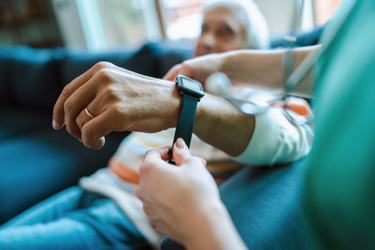De-Risk Cytokine Release Syndrome With Digital Health Tech
By Samantha McClenahan, program lead, digital measures & diagnostics, Digital Medicine Society (DiMe)

CAR T cell therapies have revolutionized cancer treatment, offering new hope for patients with conditions like multiple myeloma. However, these groundbreaking treatments come with a significant challenge: nearly 80% of patients undergoing CAR T cell therapy experience cytokine release syndrome (CRS), a serious adverse event that can complicate patient care and drive up healthcare costs. As these therapies expand into clinical trials for non-oncological diseases like multiple sclerosis and lupus, managing CRS becomes even more complex. Early detection and prediction of CRS are essential to improve patient safety and lower the associated costs of these therapies.
The Complexities Of CRS In Immunotherapy
If left unaddressed, CRS can lead to severe complications, jeopardizing patient safety and increasing treatment costs. The complexity of managing CRS intensifies as therapies move beyond oncology into new therapeutic areas. The inability to predict which patients will develop CRS, particularly those at risk for progression, exacerbates the problem. This unpredictability limits the ability of patients to return home safely and complicates the inclusion of a broad, diverse patient population in clinical trials. Despite the need, the industry has lacked products that can reliably predict CRS, creating a critical gap in patient care and trial efficiency.
Current inpatient monitoring for CRS is costly and restrictive. Manual, intermittent monitoring of vital signs during extended hospital stays present an incomplete view of CRS development and progression, placing a strain on healthcare providers and resources. This fragmented approach hinders real-time management and limits the generalizability of data for outpatient settings. To address this, more frequent, continuous data collection is vital for improving both prediction and management of CRS.
Advancing The Development Of CRS De-Risking Products
A precompetitive collaboration led by the Digital Health Measurement Collaborative Community (DATAcc) by the Digital Medicine Society (DiMe) has provided a critical set of actionable resources for advancing CRS prediction efforts by identifying early warning measures of CRS, providing a strategic approach for product development and offering recommendations for design and development, including clinical evidence generation. The resources are specifically designed to enhance data collection within clinical trials while supporting the development of data-driven predictive products that can help predict CRS across a range of therapies.
One core aspect of these resources is their support for identifying early warning measures. Rather than relying solely on intermittent monitoring for CRS symptoms, the focus of CRS detection shifts to proactive risk mitigation by incorporating continuous monitoring into clinical workflows. Using the common digital clinical measures set, researchers can capture early indicators of CRS, offering the ability to detect CRS before standard of care. This approach requires integrating early CRS measures into existing monitoring practices, whether in the clinic or outpatient settings, leveraging digital health technologies (DHTs) to collect timely, actionable data.
Moreover, these resources promote a structured approach to standardizing data collection across trials. A significant challenge in CRS research has been the variability in data collection and reporting across different trials. By using these resources, researchers can align their trials with best practices for data collection, ensuring comparability across studies. This consistency is vital for building predictive models that can be validated with diverse data sets, enhancing the models' reliability and real-world applicability.
The resources also offer important considerations for selecting and deploying DHTs capable of continuously monitoring patients at risk for CRS. The resources outline the key considerations for selecting DHTs based on the technical considerations, the patient population, and treatment setting. Researchers can deploy DHTs in their trials, ensuring that the monitoring process is not only accurate but also scalable and adaptable to different environments, whether in hospital settings or at home. For example, a wearable patch that continuously tracks temperature can be implemented in both settings to detect CRS up to 5 hours earlier than the existing standard of care, ensuring timely clinical intervention.
Through strategic planning, these resources support the development of CRS de-risking products that are clinically relevant and commercially viable, enabling device developers to create solutions that meet clinicians’ needs and generate real-time data to improve predictive models. These products will help bridge the gap between research and clinical practice, ensuring that the data-driven solutions developed for CRS are actionable and impactful in real-world applications.
Shaping The Future Of CRS Risk Prediction In Clinical Trials
Looking forward, CRS risk prediction products will play a crucial role in enhancing patient safety and improving treatment strategies in immunotherapy trials. By incorporating CRS risk prediction products as exploratory endpoints, researchers can continuously assess the likelihood of CRS, facilitating more effective management of CRS and monitoring farther from the hospital. These products, powered by DHTs, will facilitate continuous monitoring of patients, aiding researchers in identifying high-risk individuals and potentially reducing high-grade CRS.
Ongoing data collection and collaboration across clinical trials will be essential to identifying reliable safety biomarkers for CRS. By standardizing data across studies, researchers can build more robust predictive models that improve the accuracy of CRS risk prediction. These products will enhance early identification of patients at risk, ultimately improving patient safety and enabling faster interventions.
As CRS risk prediction products evolve, they will transition from exploratory endpoints to qualified safety biomarkers, laying the groundwork for more personalized and efficient treatments in immunotherapy. This shift will not only enhance clinical outcomes but also will allow for faster regulatory reviews, streamlining the approval of new therapies and accelerating access to life saving treatments.
Advancing CRS Prediction With Digital Health
The integration of DHTs and CRS risk prediction products is vital for advancing the safety, accessibility, and affordability of immunotherapies like CAR T cell therapy. By embracing early detection, remote monitoring, and collaborative data collection, we can improve patient outcomes, reduce healthcare costs, and ensure that innovative treatments are safe and effective for a broad patient population.
For the future of immunotherapy trials, researchers, clinicians, and device developers must continue working together, leveraging innovations in digital health to create data-driven solutions. This collaboration will transform how therapies are developed, bringing safer, more effective treatments to market faster and improving outcomes for patients worldwide.
About The Author:
 Samantha McClenahan is a program lead at the Digital Medicine Society (DiMe), a global non-profit and the professional home for digital medicine, where she leads cross-disciplinary digital health projects that advance the use of digital health measurement and diagnostics to improve health outcomes, economics, and equity. Most recently she facilitated a collaboration among diverse stakeholders to advance the development of cytokine release syndrome (CRS) de-risking products.
Samantha McClenahan is a program lead at the Digital Medicine Society (DiMe), a global non-profit and the professional home for digital medicine, where she leads cross-disciplinary digital health projects that advance the use of digital health measurement and diagnostics to improve health outcomes, economics, and equity. Most recently she facilitated a collaboration among diverse stakeholders to advance the development of cytokine release syndrome (CRS) de-risking products.
Prior to DiMe, Samantha worked in preclinical development of biologics and small molecules across a variety of therapeutic areas and molecular targets. She has a Ph.D. in pharmacology and interdisciplinary toxicology from the University of Arkansas for Medical Sciences and a postdoctoral fellowship in the Department of Anesthesiology at Vanderbilt University Medical Center, where she focused on translational research.
